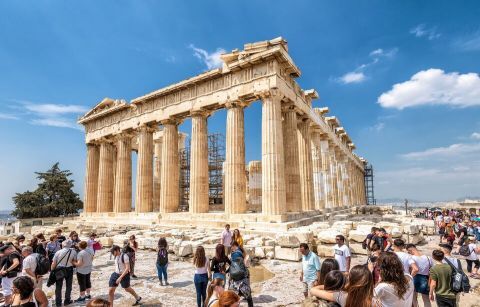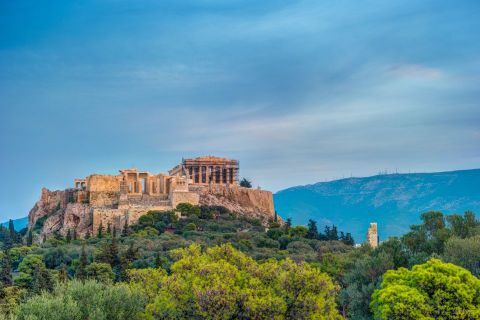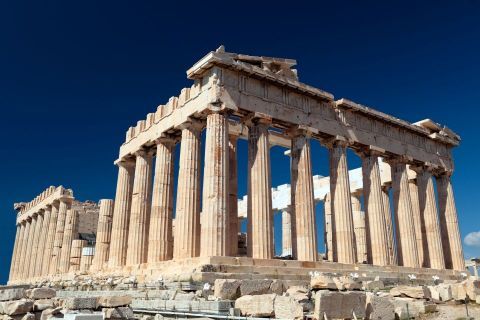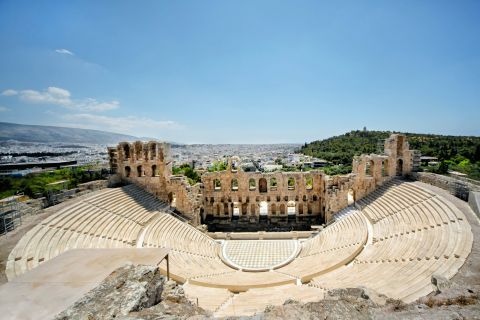Athens Acropolis
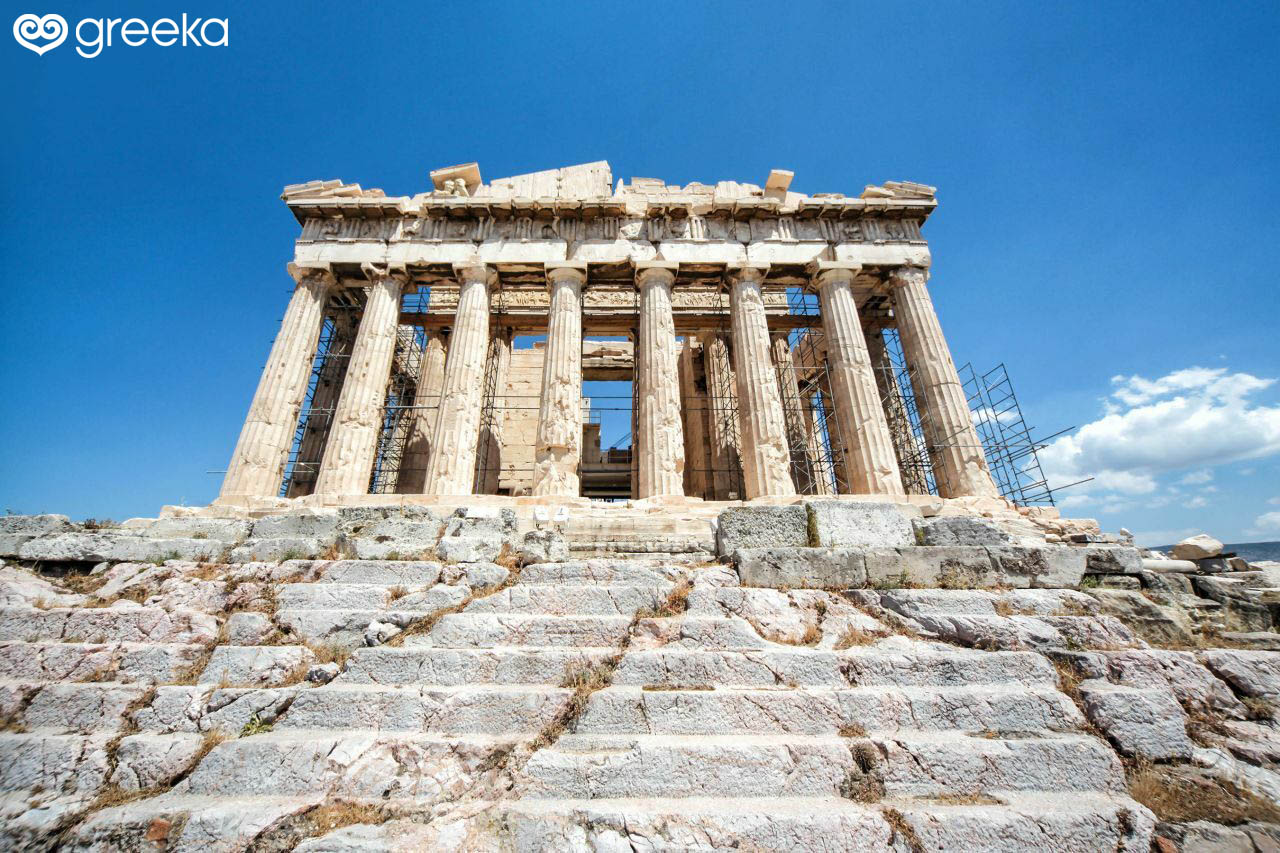
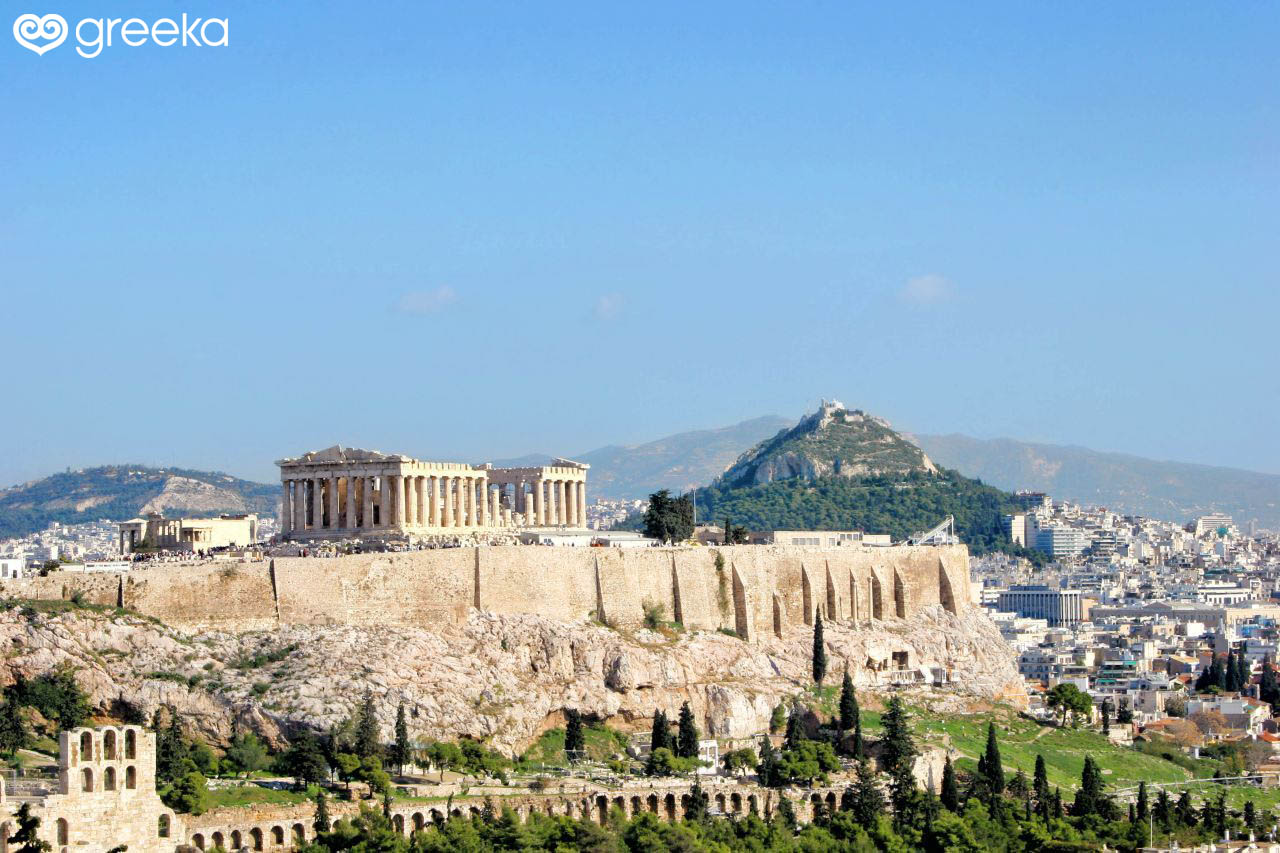

• General info • Tours & Activities • Map • Members Photos (821) • Greeka Photos (29) • Reviews (1)
Location: Acropolis
The Acropolis of Athens, or the Sacred Rock as it is called, is considered the ultimate symbol of ancient Greek civilization and culture.
It is the trademark of the capital and the whole of Greece and is one of the most significant and majestic monuments in Europe.
Jump to:
• History • Parthenon • Southwest slope
Both the Acropolis and the Parthenon, the imposing temple dedicated to the goddess of wisdom Athena, are visible from almost all parts of the city.
The Acropolis Museum, formerly housed next to the Parthenon, now houses its exhibits in a beautiful modern building on Areopagitou Street.
SKIP THE LINE! ACROPOLIS AND MUSEUM ENTRY TICKETS!
Skip the long queues and explore the Acropolis and the Acropolis Museum at your own pace.
Buy your tickets online!
The Acropolis rock is 156 meters above sea level.
It is considered a landmark for Athens, with its history linked to religious festivals, myths and struggles throughout the centuries. Since 1987 it has been a monument protected by UNESCO as a cultural site.
The monuments on it are awe-inspiring to look at from any distance, not only because of their innovative and impressive architecture but also because of the fact that they have witnessed most of the city's happiest moments and darkest days.
History
The history of the Acropolis goes way back. More specifically, it dates back to the Neolithic Age.
In the 3rd millennium BC, a fortified settlement was built on the hill, as the location was favored by the natural protection offered by the altitude and the existence of springs on the slopes.
During the Mycenaean period (c.1750-1050), the settlement began to expand. After a while, the Acropolis became the center of power for all of Attica (except Elefsina). In fact, according to mythology, it was Theseus who united the small cities of Attica and formed Athens.
Then, the Acropolis was fortified with walls, created from large carved stones.
Originally, the Acropolis was the residence of the ruler, in the place where the Erechtheion is today. However, when Athens was transformed into an asty (town) and the one-man power began to weaken, the rock became a place of religious worship.
In the 8th century BC, a small temple dedicated to Athena Polias was built on the site of the Mycenaean royal palace. A wooden statue of the goddess made of olive wood, her symbol tree, was kept inside it. Next to the temple stood the remnants of the battle between Athena and Poseidon - the olive tree that the goddess herself planted in Athens and offered as a gift to the Athenians and the marks from Poseidon's trident when the god struck it on the earth to make seawater gush forth. Besides these, the tomb of the mythical king of the city, Kekropas, is also located at the site.
In the 6th century BC, a sanctuary dedicated to Athena Pallas (patroness of the inhabitants during wars) was built and named Ekatompedon. The Mycenaean walls were preserved until 480 BC when they were destroyed along with all the temples of the Acropolis during the seizure of Athens by the Persians.
With the end of the Persian Wars, the rebuilding of the walls and the construction of new sanctuaries began. This act was an initiative of the great statesman Pericles, who aimed to make Athens strong again and restore the glory it once had.
During the 5th century BC (Pericles' Golden Age), the construction of the impressive monuments that we admire to this day (the Parthenon, the Erechtheion, the Propylaea and the Temple of Athena Nike) began under the supervision of Phidias, Callipratis, Mnesikles and Callimachus.
As for the wall, Themistocles was a strong supporter of its reconstruction and strengthening, which is why the northern part of the walls was named after him (Themistoclean Walls). The construction of the southern section was completed by Kimon, which is why it was also called the Kimonean Walls.
In the 3rd century AD, interventions began to take place in the fortification of Athens. Thus, the late Roman (Valerian) wall was built lower than the rock of the Acropolis. During a devastating raid by the Heruli in 267 AD, the roof of the Parthenon was burnt down.
In the 6th century AD, the Parthenon was converted into a Christian church dedicated first to the Wisdom of God and then to the Virgin Mary of Athens. In fact, the Byzantine emperor Basil II went to worship the Virgin Mary after his victory over Tsar Samuel of Bulgaria.
During the Frankish occupation (13th-14th century), the Parthenon was converted into a Catholic church. Two new churches were built on the sacred rock of the Acropolis, one above the Propylaea and one in the northeastern part, where the Greek flag stands today.
Extensive damage occurred during the Ottoman occupation, during which the hill's top had become a castle for the Turkish garrison and the Parthenon was used as a mosque. In 1645, a lightning struck the Ottoman gunpowder magazine, causing it to blow up and partially destroy the Propylaea.
Unfortunately, this was not even the worst event. In 1687, during the Ottoman-Venetian War, the Venetian Francesco Morosini bombed the sacred rock and a bombshell blew up the Parthenon, which served as the Turks' gunpowder magazine.
The suffering of the monuments continued with the actions of the Scottish diplomat, Lord Elgin. Shortly before the Greek Revolution of 1821, Elgin, with the help of workers, stripped the Acropolis monuments.
More specifically, Elgin sawed and removed from the Parthenon 56 frieze panels, 15 fronts and a large number of decorative statues from the pediment. In addition, he cut off a Caryatid and a column from the Erechtheion, as well as many parts of the frieze of the temple of Athena Nike. In 1816, he sold them to the British Government and they are now exhibited in the British Museum. To raise awareness on the subject, the place of the sixth Caryatid of Erechthion in the Acropolis Museum remains vacant.
During the Greek Revolution, the Acropolis was alternately besieged by the Ottomans and the Greeks and new destruction was caused.
Finally, after the end of the war for independence and the establishment of the new Greek state, the once-again-Greek Acropolis became accessible to the public again in 1835.
The Parthenon
The Monument
The Parthenon is the most characteristic and famous monument of the Acropolis.
It was built on the ruins of the archaic Ekatompedon on the initiative of Pericles in 447 BC, as part of his plan to rebuild the temples of the Acropolis after their destruction by the Persians in 480 BC.
The architects who undertook its design were Ictinus and Callicrates. The temple, built in honor of the goddess Athena, is 70 meters long (17 columns), 31 meters wide (8 columns) and 19 meters high. Its style is Doric but also shows elements of Ionic style as shown in the frieze. The material used for its construction is marble from Mount Pentelikon.
The construction of the building was completed in 438 BC, while the last decorative statues were added in 432 BC.




The Decoration
The Parthenon featured three types of architectural sculpture - the metopes, the pediments and the frieze.
The metopes are rectangular slabs with reliefs from the mythology of Athens. The western side depicts the battle of the Amazons, the eastern side the Gigantomachy, the northern side the Trojan War and the southern side the Centauromachy. The sum of the plates was 92!
Pediments are triangular-shaped gables. The Parthenon has two, featuring statues of gods and deities. The eastern one depicts the birth of the goddess Athena while the western one depicts the Athena-Poseidon fight over who will take Athens under his protection.
Finally, the frieze is the zone of relief around the main interior of the monument. It is 160 meters long and depicts the procession of the Panathenaic procession, a festival held in honor of the goddess Athena. The Parthenon frieze has 378 human figures and more than 200 animal figures carved into it!
Inside the Parthenon was a huge statue of Virgin Athena with a Nike (Victory) in her hand, made of gold and ivory. The creation of the 12-metre statue was supervised by the famous sculptor of the time, Phidias.
The space was surrounded by Doric columns on three sides.
The western room (Opisthodomos) housed the treasury, where, among other things, the money of the Athenian Alliance was kept.
The entrance to the interior of the temple was through the eastern central door.
In 334 BC, Alexander the Great dedicated gold-plated shields to the Parthenon after his victory at the Granicus River.
In 288-295 BC, however, the tyrant Lacharis removed the shields and the gold from the statue of Athena to be exploited by himself and his army.
In Roman times, an inscription with metal letters was added to the monument in honor of Emperor Nero.
The most unfortunate thing happened in 267 AD when the Heruli invaded Athens and as part of their plunder, they burned the roof and interior of the Parthenon, including the majestic statue of Athena.
The Erechtheion
Erechtheion was built between 421 BC and 406 BC after several interruptions due to the Peloponnesian War and the death of Pericles. It is a temple in Ionic style dedicated to Athena and Poseidon, but in which other gods and heroes were worshipped. It is built on the site of the former Mycenaean palace.
The eastern part of the temple was a place of worship of Athena. There was a wooden statue of Athena, which predates the temple. Outside the place was the olive tree planted by the goddess herself and offered as a gift to the inhabitants of Athens.
The western part was dedicated to the god of the sea, Poseidon.
The southern part is perhaps the most famous, because of its prostration with the Caryatids. The Caryatids are columns in the form of women that enclose the place where the mythical king of Athens, Kekropas, was buried. In Erechthio there were altars to Zeus, Hephaestus and the local hero Voutis.
The architect who designed the Erechtheion has not been ascertained, but it is presumed to be Mnesikles.
It is undoubtedly a monument of great architectural importance, as its design is multiform and idiosyncratic.
To the west of the temple is the Pandrosium, a stoa dedicated to Nymph Pandrosos, daughter of Kekropas.




The Temple of Athena Nike
The temple of Athena Nike was built between 427 and 424 BC. It is an Ionic temple at the southwestern end of the sacred rock of the Acropolis. The architect who designed the temple was Kallikrates and marble from Mount Pentelikon was used for its construction.
Since the time of the Persian Wars, Athena was worshipped there as the goddess of victory in war.
The temple is small in size but was richly decorated with sculptures. The majority of the pediments have been lost, but evidence suggests that the eastern pediment may have depicted the Giant's Battle while the western pediment may have depicted Amazonia.
The frieze is Ionic and depicts an assembly of the gods of Olympus in the eastern part, battles between Greeks and Persian knights in the southern part and battles between hoplites and other hoplites.
In 410 BC, a marble vault with reliefs was added to the temple for the protection of visitors. The representations depicted the goddess Athena seated watching winged Victories leading bulls in sacrifice or holding weapons and adorning victorious trophies.
Pausanias named the temple "Temple of Apteros Nike" after the statue that had been built in honor of Athena Nike. The adjective apteros (meaning without wings) refers to the fact that the goddess was represented without wings so that she could always stay in Athens.
The Propylaea
The Propylaea were built between 437 BC and 432 BC. The first plans were made by Mnesikles, but were not completed due to the outbreak of the Peloponnesian War.
They are located at the western end of the rock and form the entrance building to the sanctuary of Athena.
The monument consists of a central entrance and two side wings.
The entrance is flanked by three pairs of Ionic columns. It has five doors, the middle one being wider than the others, in order to facilitate the passage of the procession of the Panathenaeans and the animals destined for sacrifice.
In the north wing there is a space called Pinakothiki (Gallery). This is due to reports by Pausanias, who wrote that paintings depicting scenes from the city's past were housed there.
In the 6th century AD the south wing of the temple was converted into a Christian basilica.
During the Middle Ages, the Franks made changes to the Propylaea as they intended to use it as a palace.
In 1645, during the Ottoman rule, a lightning bolt caused the monument to be blown up as it was filled with gunpowder.
Finally, in the 19th century, Lord Elgin removed a Doric capitals, part of an Ionic quoin and a throne stone from the south wall from the monument.
Attempts to restore the Propylaea were made by the civil engineer Nikolaos Balanos between 1909 and 1917 and by the architect Anastasios Orlandos between 1947 and 1956. From 1975 to the present day, the conservation work has been undertaken by the Acropolis Monuments Conservation Committee.




The Panathenaic Way
The Panathenaic Way was the route taken by the Panathenaic procession during the Panathenaic Games.
This was the most important event of ancient Athens and cultivated unity among the residents. It was dedicated to the goddess Athena, the protector of the city.
The route was cutting through the middle of the Acropolis, beginning from Kerameikos and ending at the Erechtheion.
The procession was the highlight of the celebration, as it took place on its last day.
It featured men carrying animals for sacrifices to the goddess, maidens carrying drinking vessels (called rhytons), musicians and girls holding the sacred shawl called peplo.
The procession came to an end when the girls placed the peplo on the statue of Athena Polias inside the Erechtheion.
The statue of Athena Promachos
In antiquity, the gigantic statue of Athena Promachos (the one who fights in the first line) stood fifteen meters from the Propylaea.
It is possible that the statue was the inspiration and model for the golden statue of Athena hosted inside the Parthenon.
The 9-meter-high statue was a symbol of the victory of the Athenians against the Persians. In fact, it was built using money obtained by the Athenians as loot after the battle of Marathon.
This symbolism is the reason why its sculptor, the renowned Phidias, represented the goddess holding a shield in her left hand and a spear in her right one. The goddess' shield depicted the Centauromachy.
The statue was moved to Constantinople in 465 AD and its fate has remained unknown ever since.
Nowadays, only the pedestal on which the statue stood is apparent.
The southwest slope of Athens Acropolis
This southwest slope of the Acropolis is the area where all public buildings were situated.
It was also the part of the hill where all the major artistic, spiritual and religious activities of the city took place, hence its importance to ancient Athens.
The most important monuments standing in this area include:
The Theatre of Dionysos
The ruins of the 5th-century Theatre of Dionysos built with stone and marble by Lycourgos indicate the greatness of the site.
The auditorium had approximately 16,000 seats of which only 20 rows survived.
During the golden age of Pericles, when Athens was at its heyday, one of the major events was the annual Dionysia Festival, introduced in the 6th century BC by the tyrant Pisistratus.
It was a significant cultural event, where theatrical plays by Aristophanes, Aeschylus, Euripides, and Sophocles (among others) were presented. To be exact, the plays of the four prestigious playwrights were first hosted in the Theatre of Dionysus.
Visitors would come from all around Attica to enjoy the plays and the different festivities.
The Romans also used the Theatre of Dionysos for their state events, ceremonies, and even theatrical performances.
The Greek Archaeological Society started excavations around the sanctuary of Dionysos and brought to light the theatre of Dionysos in 1838.
The decorative relief at the rear of the stage dates back to the 2nd century BC and depicts Dionysos' life and myths.
Unfortunately, most of the figures are headless.




Odeon of Herodes Atticus
The Odeon of Herodes Atticus was built by Tiberius Claudius Atticus Herodes, a wealthy benefactor who was a scion of a revered Athenian family.
He offered the money for the construction of this architectural miracle in 160 AD in memory of his wife Regilla.
The huge construction has a 38-meter radius, which allows it to offer space for more than 5000 spectators. The seats were made of marble.
In 1856, large-scale works began, leasing to the excavation of the odeon's stands in the two years that followed.
The monument was restored in 1952-1953 and has been used for cultural events ever since. The annual Athens Festival uses the Theatre of Herodes Atticus for musical and dancing performances and theatrical plays.
Famous artists and performers from all over the world come to Greece to perform in this awe-inspiring setting.
The Choragic Monument of Thrasyllos
This monument was erected in 320-319 BC by Thrasyllos above the Theater of Dionysus. Like all sponsorship monuments, it was built to house the trophy for the winner of the dramatic games taking place in the theater (Thrasyllos had sponsored the winners of that year's contest).
The monument was built in a prominent place on the slopes of the Acropolis and covered an entrance to a cave. Both - the monument and the cave - ended up a church called Panagia Spiliotissa (the Virgin Mary of the Cave) during the Christian era and remained in very good condition until 1827, when a bombshell thrown by the Ottomans destroyed it extensively.
Fortunately, a large part of the monument was restored in 2017.
The Asclepieion
The Asclepieion was built in 420 BC to worship the god of medicine, Asclepius, and his daughter, Hygieia (Health).
It is located on the left top of the wooden steps leading to the Theatre of Dionysos.
The sanctuary includes the shrine and altar of Asclepius, a Doric stoa and an Ionic stoa. The Doric stoa served as a venue for patient overnight stays while the Ionic stoa had restaurants and served as lodging for Asclepius' priests and visitors. A spring with blessed water and an offering pit were also part of the sanctuary's premises.
The excavation of the Asclepieion was made by the Greek Archaeological Service.
The Stoa of Eumenes
Beneath the Asclepion stands a long colonnade that was built by Eumenes II, the king of Pergamos (197-159 BC).
Its remnants are situated between the Odeon (Theatre) of Herodes Atticus and the Theatre of Dionysus.
This colonnade is known as the stoa of Eumenes, built of stone and marble and used as a shelter and a promenade way for the theatre's public during antiquity.
Top Tours and activities
-
Best Seller
![Skip the line! Acropolis and Museum Entry Tickets 1]()
Skip the line! Acropolis and Museum Entry Tickets
Book nowfrom € 37.00Category: City30 days MapExplore Athens’ famous sights, the Acropolis and the Acropolis museum at your own pace skipping the long lines. Save time and energy. These tickets are easy to collect and can be redeemed any day within the next 30 days.
-
Best Seller
![Skip the line! Acropolis Entry Ticket 1]()
Skip the line! Acropolis Entry Ticket
Book nowfrom € 23.50Category: City1 day MapSkip the ticket line at the Acropolis of Athens with a pre-booked ticket sent to your phone. Explore the site at your own pace, see significant monuments, and marvel at the UNESCO-listed Parthenon Temple.
-
Best Seller
![Acropolis Ticket with Pickup Point 450m from South Entrance 1]()
Acropolis Ticket with Pickup Point 450m from South Entrance
Book nowfrom € 13.00Category: City, Day Trips1 day MapCollect your ticket from the local supplier's office and explore the Acropolis at your own pace. Skip the long lines and visit one of the world's most famous ancient monuments.
How to get there
There are many ways to reach the ancient site of the Acropolis from any location in Athens.
Tours: Discover the Acropolis with an organized tour.
Private transfers: We recommend using an online pre-booked transfer service, which provides transfer by taxi, minibus, or private VIP car and arranging a pickup directly from the port, airport, or your hotel. Alternatively, there’s the option of arranging a pickup by a local driver directly at the following numbers: (0030) 18288, (0030) 18222, (0030) 18180. You can also book your taxi online.
On foot: As the Acropolis is located in a central area of Athens, it can be easily reached on foot from Syntagma Square in approximately 20 minutes.By metro: The closest metro station is Akropoli (Red Line). Note that in order to reach the Acropolis, a 15-minute walk is needed. Get a map of the metro here.
By bus/trolleybus: The closest bus stop is "Akropoli" (Bus line 230). The Ancient site of the Acropolis is located within a 5-minute walking distance from the bus stop. Check the routes and the official timetables on OASA Telematics.
Photos by Greeka Members
Photos by Greeka Team
Map
Reviews
-
georgia 29 Mar 2022Over and beyond us
Acres and statues, and also, columns, of a distant era towards the skies of the future. the major citadel of Athletes, gods, and rhythms. for centuries, it stands over, the city of Athens. the well-known acropolis, with the debris, and the liberty sculpts, feminine figures, and austere geometry. though the are no intact signs, if we do exist, at the same time, of our past ancestors, throughout the future. strolls aren't ready made, you ll need a company/ a good weather or none of the above. you may have to offer yourself the view, of exquisite sub-temples and the suburbs of west/east/north/south dominion. a map that is Greek, uses, a hypo-text of symbols, usually with colored, petty images, and numbers of the population and other statuses. thanks to modern societal norms, flags of other countries, and stats might be also found..
